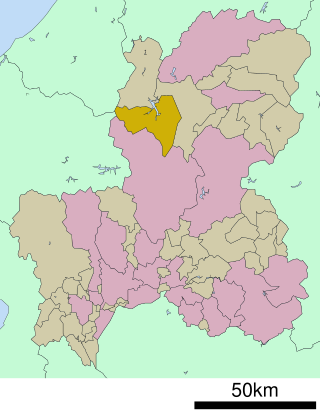
Shōkawa was a village located in Ōno District, Gifu Prefecture, Japan.
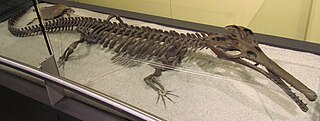
Champsosaurus is an extinct genus of crocodile-like choristodere reptile, known from the Late Cretaceous and early Paleogene periods of North America and Europe (Campanian–Paleocene). The name Champsosaurus is thought to come from champsai, (χαμψαι) said in an Ancient Greek source to be an Egyptian word for "crocodiles", and sauros, (σαύρος) Greek for "lizard". The morphology of Champsosaurus resembles that of gharials, with a long, elongated snout. It was native to freshwater environments where it likely preyed on fish, similar to living gharials.

Choristodera is an extinct order of semiaquatic diapsid reptiles that ranged from the Middle Jurassic, or possibly Triassic, to the Miocene. Choristoderes are morphologically diverse, with the best known members being the crocodile-like neochoristoderes such as Champsosaurus. Other choristoderans had lizard-like or long necked morphologies. Choristoderes appear to have been confined to the Northern Hemisphere, having been found in North America, Asia, and Europe, and possibly also North Africa. Choristoderes are generally thought to be derived neodiapsids that are close relatives or members of Sauria.
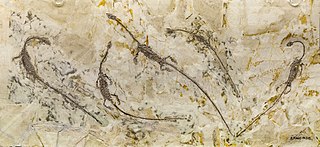
Hyphalosaurus is a genus of freshwater aquatic reptiles, belonging to the extinct order Choristodera. They lived during the early Cretaceous period, about 123-120 million years ago. The genus contains two species, H. lingyuanensis from the Yixian Formation and H. baitaigouensis from both the Yixian and Jiufotang Formation of Liaoning Province, China. They are among the best-known animals from the Jehol Biota, with thousands of fossil specimens representing all growth stages in scientific and private collections.
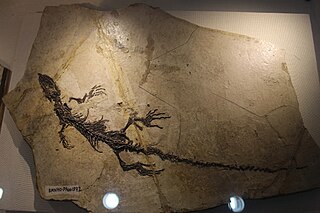
Yabeinosaurus is an extinct genus of lizard from the Early Cretaceous Jehol Group of northeastern China. The type species Yabeinosaurus tenuis is known from many well-preserved skeletons belonging to both juvenile and adult individuals. For about 60 years Yabeinosaurus was known only from juvenile specimens, leading scientists to believe that it was a small lizard with weakly developed bones. Because of this, it was thought to be closely related to geckos. Larger specimens up to 35 centimetres (14 in) snout‐vent length.

Lazarussuchus is an extinct genus of amphibious reptile, known from the Cenozoic of Europe. It is the youngest known member of Choristodera, an extinct order of aquatic reptiles that first appeared in the Middle Jurassic. Fossils have been found in Late Paleocene, Late Oligocene, Early Miocene and possibly Late Miocene deposits in France, Germany, and the Czech Republic. Two species have been named: the type species L. inexpectatus ("unexpected") from the late Oligocene of France. and L. dvoraki from the early Miocene of the Czech Republic. It was not a large animal; with the total preserved body and tail length of L. inexpectatus being just over 30 centimetres. A complete specimen of Lazarussuchus with preserved soft tissue was found from the Late Paleocene of France, but has not been assigned to a species.
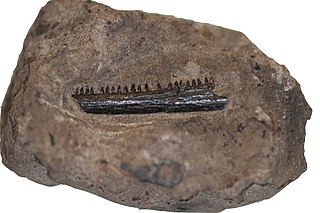
Cteniogenys is a genus of choristodere, a morphologically diverse group of aquatic reptiles. It is part of the monotypic family Cteniogenidae. The type and only named species, C. antiquus, was named in 1928 by Charles W. Gilmore. The holotype, VP.001088, was collected in the Morrison Formation, Wyoming in 1881 by William H. Reed. More specimens have been discovered since then, including specimens from the Late Jurassic of Portugal and Middle Jurassic of Britain, which have not been assigned to species.
The Kuwajima Formation is an Early Cretaceous geologic formation in Japan. Its precise age is uncertain due to a lack of identifying fossils, and it was previously considered likely Valanginian to Hauterivian in age. However, it is now considered to probably be Barremian in age. Dinosaurs and other vertebrates has been recovered from the Kaseki-kabe "Fossil-bluff" locality in the uppermost part of the formation.
The Okurodani Formation is an Early Cretaceous geologic formation in central Honshu, Japan. Part of the Tetori Group, it primarily consists of freshwater continental sediments deposited in a floodplain environment, with occasional volcanic tuffite horizons. It has an uncertain age, probably dating between the Hauterivian and Aptian. An indeterminate iguanodontian dinosaur tooth has been recovered from the formation. Many other fossil vertebrates are known from the KO2 locality

Monjurosuchus is a genus of choristoderan reptile that lived in what is now China and Japan during the Early Cretaceous. It has large eyes, a rounded skull, robust legs with short claws, and a long, thin tail. Fossils have been found that preserve soft tissue, showing that it had soft skin and webbed feet.

Khurendukhosaurus is a genus of choristodere, a type of amphibious reptile. It is known from Lower Cretaceous rocks of Mongolia and Russia. Two species have been named. The type species, K. orlovi, was named in 1984 by Sigogneau–Russell and Efimov for the fragmentary postcranial skeleton PIN 3386/3. This specimen was discovered in the Albian-age Lower Cretaceous Khuren Dukh Formation Formation at Hüren Dukh, central Mongolia. The lake deposits at this site also contain fossils of the choristoderes Irenosaurus and Tchoiria. Other postcranial bones of K. orlovi have been found at this site as well.
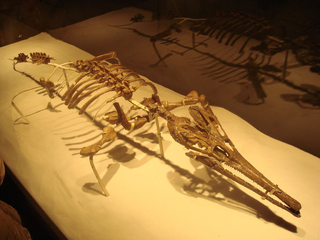
Tchoiria () is a genus of neochoristoderan reptile from the Early Cretaceous of Mongolia. The name Tchoiria comes from the city of Choir which is nearby to where the holotype was found. Tchoiria is thought to have a similar diet to another neochoristoderan reptile, Champsosaurus, due to morphology of the skull. It would hunt in freshwater environments, like the living gharials, where it would prey on many different types of fish and turtles.

Neochoristodera is a lineage of specialised crocodile-like fully aquatic choristodere reptiles. Noted for their long jaws and large size, these animals were predominant across the Northern Hemisphere, occurring in freshwater and coastal environments across the Cretaceous and early Cenozoic.

Philydrosaurus is an extinct genus of choristoderan which existed in China during the Early Cretaceous. The type species P. proseilus was named in 2005. Philydrosaurus was found from the Jiufotang Formation and is slightly younger than Monjurosuchus, which was found from the Yixian Formation.
Liushusaurus is an extinct genus of lizard described by Susan E. Evans and Yuan Wang in 2010. The genus has a single species, Liushusaurus acanthocaudata, and is known from eight fossils, several of which preserve soft tissue detail. The specimens were found in the Lower Cretaceous aged Yixian Formation of Northeast China. Liushusaurus is one of eight lizards that are known and have been named from the Yixian Formation, part of the diverse Jehol Biota ecosystem.

Chuanqilong is a monospecific genus of basal ankylosaurid dinosaur from the Liaoning Province, China that lived during the Early Cretaceous in what is now the Jiufotang Formation. The type and only species, Chuanqilong chaoyangensis, is known from a nearly complete skeleton with a skull of a juvenile individual. It was described in 2014 by Fenglu Han, Wenjie Zheng, Dongyu Hu, Xing Xu, and Paul M. Barrett. Chuanqilong shows many similarities with Liaoningosaurus and may represent a later ontogenetic stage of the taxon.
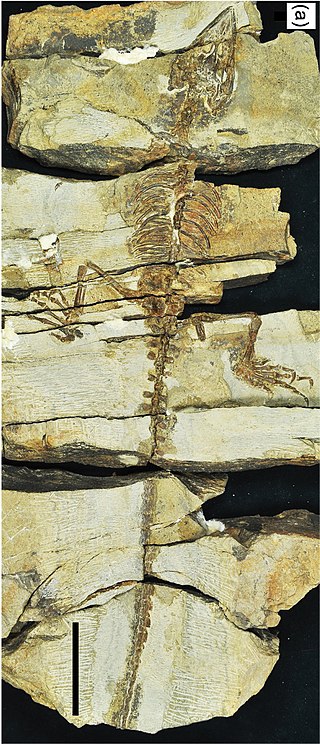
Coeruleodraco is an extinct genus of choristoderan known from the Late Jurassic (Oxfordian) Tiaojishan Formation in China. Coeruleodraco is significant as the most complete Jurassic choristodere taxon, as the only other named Jurassic choristodere Cteniogenys is based on fragmentary remains. Although similar to Philydrosaurus in its proportions and postcranial characters, it is distinct in retaining several apparently plesiomorphic characters, including a short snout, paired external nares and an open lower temporal fenestra.
This list of fossil reptiles described in 2019 is a list of new taxa of fossil reptiles that were described during the year 2019, as well as other significant discoveries and events related to reptile paleontology that occurred in 2019.
This list of fossil reptiles described in 2020 is a list of new taxa of fossil reptiles that were described during the year 2020, as well as other significant discoveries and events related to reptile paleontology that occurred in 2020.
Heishanosaurus is an extinct genus of choristodere reptile from the Early Cretaceous of China. The type and currently only known species is Heishanosaurus pygmaeus. It is unusual as it is much more primitive than other known choristoderes from the Early Cretaceous of Asia, and retains many plesiomorphic characters.













